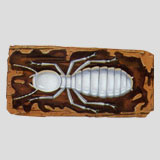Carpenter Ants or Termites?
By Chris Williams on April 1, 2013.
 Question
Question
What does carpenter ant damage look like? This weekend, I opened a wall void to do a plumbing repair and found what looks like insect damage to the stud. The wood looked layered and soft with dirt mixed in with the wood. We did find a couple of dark winged ants in the basement a week ago but didn’t think much about it. Do you think we have carpenter ants?
Answer
It would be really hard to speculate on what’s causing that damage without an actual inspection. The first thing you should do is have a professional pest control company inspect the area. They can also determine whether it’s an old, inactive infestation or a current infestation that needs treatment. What I can do is give you some information about carpenter ants and the kind of damage they do.
With carpenter ants, you usually don’t see any damage on the outside surface of the wood, but when you break into the wood you will see galleries. Carpenter ants are completely housed inside the wood with no soil connection (like termites) so there is no dirt-like material in the wood galleries. Carpenter ant galleries are clean and smooth to the touch. They feel like they have been sandpapered.
 Actually, what you describe sounds more like termite damage than carpenter ants. Both pests are common in areas with wood and excess moisture. Sounds like you may have had a plumbing leak in that space. The surface of termite-infested wood may have a blistered look or appear undamaged. Termites often continue to feed until only a thin outer shell remains. If you break into the wood, you will see that the wood inside has a honeycombed or layered appearance. The galleries will be spotted with yellowish-brown fecal spots that look like dried oatmeal, and they often contain a mixture of solid and digested wood and soil.
Actually, what you describe sounds more like termite damage than carpenter ants. Both pests are common in areas with wood and excess moisture. Sounds like you may have had a plumbing leak in that space. The surface of termite-infested wood may have a blistered look or appear undamaged. Termites often continue to feed until only a thin outer shell remains. If you break into the wood, you will see that the wood inside has a honeycombed or layered appearance. The galleries will be spotted with yellowish-brown fecal spots that look like dried oatmeal, and they often contain a mixture of solid and digested wood and soil.
There may be other clues inside the wall void, as well. Carpenter ants leave “dump piles” beneath their nest sites where they push any debris in the nest out of the wood through window-like slits. You might find piles of sawdust, mixed with dead ants, pieces of other insects, and bits of insulation or drywall. Subterranean termites travel inside mud tubes to get from their ground nest to the wood they are feeding on. The tubes are about ¼ to ½ inch wide and may be seen going up the wall, or across the wood, or may be packed into the crack where the stud meets the wall. You won’t always see tubes, however.
I wonder if the winged insects you saw could have been termite swarmers rather than carpenter ant swarmers. Both are black with wings, but termites are quite a bit smaller. There are other differences between the two that require an expert. If you see any more of the insects, save them for the pest control company. If you can, leave that wall void open because the technician will need to access that wood damage. Give Colonial a call today.